The Whole Of The Sum And Its ‘Still’ Parts: Lelarge-Pugeot’s Coteaux-Champenois Premier Cru Vrigny in Red, Rosé & White + Single-Premier Cru Champagne Vrigny & Gueux Five-Bottle Pack (3 Coteaux-Champenois + 2 Champagne $359)
It’s a cosmic, back-to-the-future shift in thinking, and it is a change sweeping Champagne in both attitude and aesthetics. For the past fifty years or so, the editorial focus on sparkling wine has tended to focus on the cellar; blending regimens and methodology. However interesting these conversations are, most winemakers have never lost sight of the fact that their product draws its primary identity from the vine. And it this expression of terroir—an afterthought through much of the twentieth century—that has moved to the front of the bus in modern discussions of Champagne as a wine, it’s first and foremost obligation.
This week’s package consists of a five-bottle sampler from one of the Montagne de Reims most forward-looking producers, the ‘Two Dominiques’—winemakers and owners Dominique Lelarge and Dominique Pugeot—of Lelarge-Pugeot. These eighth-generation winemakers feature certified organic and biodynamic vineyards, making Meunier-focused wines from lesser known lieux-dits in somewhat obscure terroirs.
Champagne Tapestry: Blending The Parts For The Whole
As the emphasis on individual terroir begins to supplant homogeneity in Champagne talking points, it is no wonder that more attention is being placed on ‘vin clair’—still Champagne prior to the added bells and whistles of cellar work. Even when a final blend is the goal, Houses like Roederer will vinify plots individually. Says Chef de Cave Jean-Baptiste Lécaillon, “I work with 410 individual parcels of vines and use 450 different vessels to ferment them. It creates a lot of work, because each of these wines is held in a separate tank until they are ready. But for me, it is vital that each plot is able to fully express its individual character.”
Blending is a Champagne paradigm; it was a blended wine even before it sparkled. Because of the cool, often inhospitable climate, combining batches from different villages and lots from other vintages was insurance against a poor harvest. Terroir, therefore, takes on a slightly different role here than it does in Burgundy, where climat blending is forbidden by law. In Champagne, an intricate tapestry is woven from villages—and vineyards—that produce still wine with contrasting, but ultimately harmonious personalities.
Far from diluting terroir, this method proves its value.
The Montagne de Reims, Grande & Petite: Variations Of Soil
Located between Reims and Épernay, the Montagne de Reims is a relatively low-lying (under a thousand feet in elevation) plateau, mostly draped in thick forest. Vines find a suitable home on the flanks, forming a horseshoe that opens to the west.
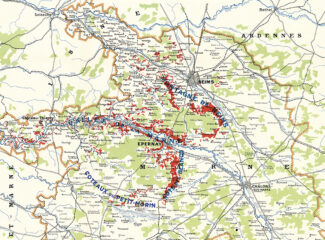
So varied are the soils, topographies and microclimates here that it is not possible to speak of the region in any unified sense. Grande Montagne de Reims, which contains all of the region’s Grand Cru vineyards, covers the northern, eastern and southern slopes of the viticultural area, and Pinot Noir plantings dominate at 57%, followed by Chardonnay (30%) and Meunier (13%). Its vineyards face a multitude of directions, and soil type varies by village, giving rise to a breadth of Pinot Noir expressions, as well as exceptional Chardonnay.
To the west, the Grande Montagne de Reims gives way to the Petite, whose bedrock is chalk, but softer than the chalk found further south on the Côte des Blancs. This sort, called ‘tuffeau’, is an extremely porous, sand-rich, calcium carbonate rock similar to what is found in wine regions of the middle Loire Valley.
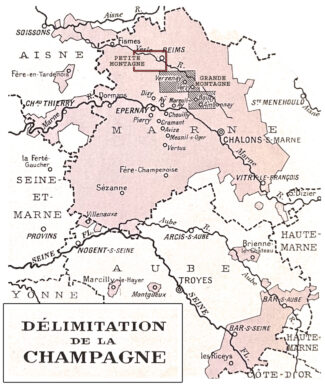
The Petite Montagne: The Primary Home of Meunier
In French, the word ‘petite’ often to refers to a ‘lesser’ commodity, but with La Petite Montagne, the reference is to elevation. This lower elevation means warmer weather, even in Champagne’s northerly climate, and in certain villages, the soils contain more sand, making it an ideal environment for growing Meunier.
Meunier accounts for approximately half of the plantings in the Petite Montagne, with Pinot Noir making up 35% and the rest Chardonnay. It is a growing conviction among growers of the modern era that Meunier is a Champagne grape whose time has come, especially as an age-worthy variety. Emmanuel Brochet of Villers-aux-Noeuds says, “People claim that Meunier ages too quickly, even faster than Chardonnay. I disagree. The curve of evolution is different. Meunier is quick to open and more approachable in youth, but then it becomes quite stable. Chardonnay tends to open later, but old Meunier remains very fresh and lively.”
Champagne & Domaine
Lelarge-Pugeot
‘Everything Starts in The Vineyard’
In 1985, when Dominique Lelarge took over his family estate, his first order of business was to improve the quality of the soil in the vineyard, and this began with a more sustainable farming approach. To this day, he views the use of pesticide an inherent threat to nature, and treats this understanding as a wake-up call: “Life is a gift from nature,” he says. “Everything starts in the vineyard, so it is important for us to respect what nature handed us.”
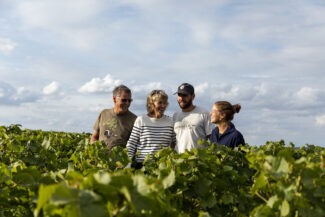
Lelarge-Pugeot
Although the Lelarge family has grown grapes in Vrigny since 1799, the last two decades have seen the leadership of the two Dominiques (winemakers and owners Dominique Lelarge and Dominique Pugeot) embrace and encourage diversity in both their ecosystem and in their outlook on Champagne production. Nestled in the Premier Cru village of Vrigny on the Montagne de Reims slopes—a mere 15 minutes west of Reims—their 21 acres are planted primarily to Meunier (11 acres), but a percentage of Pinot Noir (7 acres) and Chardonnay (3.4 acres) also figure into their blended wines.
Certified organic since 2014 and biodynamic since 2017 by Demeter, Lelarge-Pugeot encompasses 42 distinct parcels flourishing at elevations averaging 400 ft.
“We do not make wine so much as we farm vines, meticulously looking after every single step of the growth to produce the most natural Champagne possible.”
Soil Is Alive
To adopt a pesticide/herbicide free vineyard, certain concessions must be made. The beautiful thing is that they can be purely natural. When Dominique decided to stop the use of insecticides, he was able to reestablish the natural cycle of predatory wildlife in his vineyard, including ladybugs and lacewing larvae regulating spiders and caterpillars. In addition, he started growing grass between the vines for cover crop and to experiment new techniques in ploughing.
He says, “Most of this is common sense—a desire to let nature take its course—as well as a genuine concern for the next generations. We still relay on trace elements, sulfur and copper, to fight diseases. A horse ploughs our parcels in order to avoid soil compaction. We practice the green harvest, with all of the work taking place in the vineyard done meticulously and methodically.”
A third Dominique figures into the picture: “We attended a variety of classes by Dominique Massenot, who develops the Herody method to nurture the plant. Pierre Masson taught us biodynamic principles and Eric Petiot, aromatherapy, which uses of essential oils and plants to protect vines against disease. We have also started experimenting with some of our parcels in coordination with students from the Chamber of Commerce and the Comité Interprofessionnel du Vin de Champagne.”
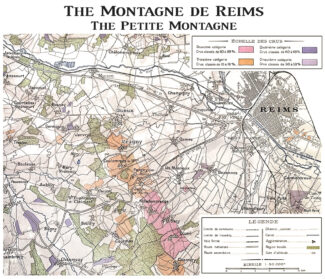
Premier Cru Vrigny
Exhibit A: The Evidence Of Things Vrigny
At its best, whether blended or not, Champagne expresses the site(s) upon which it is grown, and this is a wine fundamental that does not change because further processing adds carbonation. And it’s a fact that long before that carbonation is added, the still wine (vin clair), is evaluated at face value and many major houses isolate individual vineyards with specific characteristics at this point, the better to create a more complex and predictable final product.
Still Champagne, of course, released as a regional wine without effervescence, is the domain of a dedicated Appellation d’Origine Contrôlée: Coteaux Champenois.
If It’s Still Champagne, Is It Still Champagne?: Domaine Lelarge-Pugeot’s Premier Cru Coteaux-Champenois
Vrigny, in the northwestern part of the Montagne de Reims, is but one of a string of Champagne villages, and the last one to achieve Premier Cru status before the échelles des crus was retired. Of the 224 acres of vineyard, 71% is Meunier, 19% is Pinot Noir and 10% is Chardonnay divvied up between 40 exploitants, or vineyard owners.
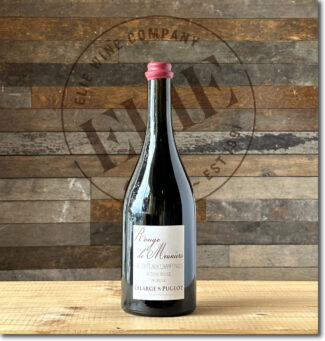 1- Domaine Lelarge-Pugeot ‘Rouge de Meuniers’, 2015 Coteaux Champenois Montagne-de-Reims Premier Cru Vrigny ($70)
1- Domaine Lelarge-Pugeot ‘Rouge de Meuniers’, 2015 Coteaux Champenois Montagne-de-Reims Premier Cru Vrigny ($70)
A still, 100% vintage-dated Pinot Meunier of astonishing power, it showcases Meunier’s ability to weave together bold fruit, earthy aromas, and elegant minerality. From 40-year-old vines grown in chalk, limestone, clay loam and sand, it spends 20 months ‘en barrique’ before release.
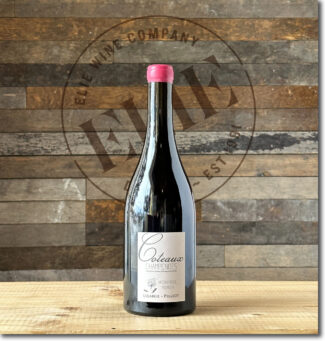 2- Domaine Lelarge-Pugeot, 2020 Coteaux Champenois Montagne-de-Reims Premier Cru Vrigny Meunier Rosé ($67)
2- Domaine Lelarge-Pugeot, 2020 Coteaux Champenois Montagne-de-Reims Premier Cru Vrigny Meunier Rosé ($67)
A zero-zero Coteaux Champenois, the family’s first ever attempt at making a still rosé made exclusively with Meunier. The Meunier is from two parcels with tiny concentrated clusters, creating a highly aromatic wine (one of Meunier’s loveliest features) of high-toned pink grapefruit, watermelon, pomegranate and tarragon with the soil’s characteristic salinity.
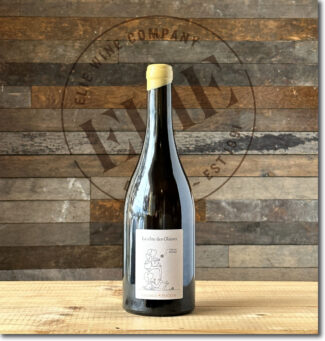 3- Domaine Lelarge-Pugeot, 2020 Coteaux Champenois Montagne-de-Reims Premier-Cru Vrigny ‘La Côte des Glaises’ Blanc Chardonnay ($79)
3- Domaine Lelarge-Pugeot, 2020 Coteaux Champenois Montagne-de-Reims Premier-Cru Vrigny ‘La Côte des Glaises’ Blanc Chardonnay ($79)
Fewer than one thousand bottles of this rich, textured, experimental still wine made from 30-year-old Chardonnay vines grown on a historical lieu-dit parcel of clay (glaise) and loam in Vrigny. Another zero/zero wine vinified with native yeasts and no added sulfur or manipulation, it shows sweet white peach and nectarine with overtones of honeysuckle and almond.
Exhibit B: Perspective. He Said, She Said
Louis Pasteur is credited with having said, “There is more philosophy in a bottle of wine than in all the books in the world.”
Sensory experiences like taste, smell and mouthfeel, on which we wax poetically in wine descriptions, are all subjective sensations. It is a relative declaration; what we believe to be true may not be the same to everyone. When it comes to Champagne, philosophically speaking, ‘quality’ isn’t necessarily objectifiable nor a separable element, but that does not make discussions of our own perceptions of quality less valid. Yet, nearly all of us fall under the spell of magic that the beverage elicits.
Champagne is a mind sport; although in our notes we call out memory-triggers (like brioche and green apple), in fact, we do not pretend that they are separate components as would be the case, say, if you spread a warm brioche with green apple jelly. They are harmonious constituents that we recognize as ultimately unified within a whole. It is perhaps this unification of disparate but complimentary elements that make up the Champagne experience, and, in fact, of all gustatory exclamations.
Revealing Vrigny: Lelarge-Pugeot Single Premier-Cru Champagne
The following wines are built around Premier Cru Vrigny terroir which express their individuality while building to a whole that speaks to the nose, the tongue and ultimately, the mind.
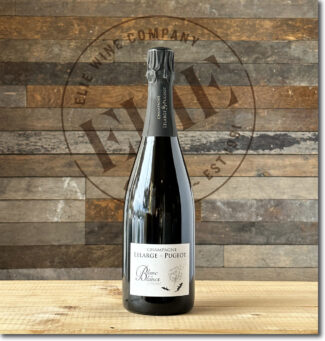 4- Champagne Lelarge-Pugeot, Montagne-de-Reims Premier Cru Vrigny Blanc-de-Blancs Extra-Brut ($66)
4- Champagne Lelarge-Pugeot, Montagne-de-Reims Premier Cru Vrigny Blanc-de-Blancs Extra-Brut ($66)
Built from a blend of different Chardonnay parcels grown on sandy loam; 60% of the wine comes from the 2014 harvest and the rest from the reserve. The wine ages for six months in tank before bottling, then spends four years on the lees in bottle. The grapes from these parcels create a regal and precise expression of the terroir, full of floral aromas, ripe pear, peach and citrus notes complemented by a subtle twist of orange peel and dried fruit complexity. Disgorged September 2021.
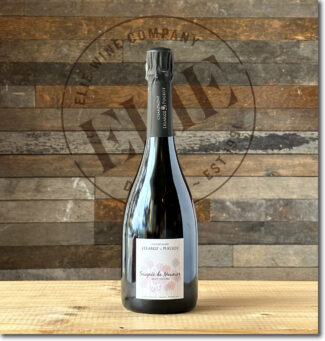 5- Champagne Lelarge-Pugeot ‘Saignée de Meunier’, 2015 Montagne-de-Reims Premier Cru Vrigny Rosé Brut-Nature ($79)
5- Champagne Lelarge-Pugeot ‘Saignée de Meunier’, 2015 Montagne-de-Reims Premier Cru Vrigny Rosé Brut-Nature ($79)
100% Meunier from the 2015 harvest, drawn from 50 year old vines; saignée style, with 32 hours of skin contact and six months of barrel-aging followed by six years on the lees in the bottle. Zero dosage and no filtering. A fine bead and an elegant raspberry/salmon pink that suggests strawberries and Morello cherries on the nose, with an electric mouthfeel and a long, mineral-driven finish. Disgorged June 2021.
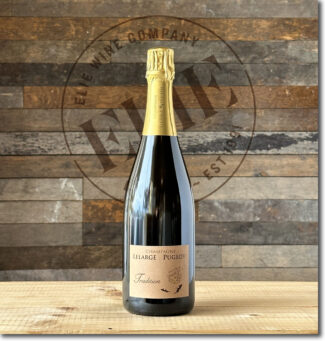 Champagne Lelarge-Pugeot ‘Tradition’, Harvest 2018 Montagne-de-Reims Premier Cru Vrigny Brut ($66)
Champagne Lelarge-Pugeot ‘Tradition’, Harvest 2018 Montagne-de-Reims Premier Cru Vrigny Brut ($66)
Lelarge-Pugeot’s entry-level, non-vintage Champagne from the 2018 harvest—a blend of 30 different plots in Vrigny. 50% Meunier, 40% Pinot Noir and 10% Chardonnay, the wine was aged for six months in tank before bottling, then spent three years on the lees. A nice textured wine behind notes of citrus, apricot, white toast and lime zest. Disgorged July 2022.
Trilogy: ‘Destination Moon’
As a child, I remember treasuring a Tintin cartoon where Hergé (Tintin’s Champagne-loving father), sent a bottle of Champagne (Brochet-Hervieux, now called Champagne Vincent Brochet) to the moon. It somehow seems fitting that the image captured by Dom Perignon’s famous exclamation, “I’m drinking stars,” found another outlet in the night sky. This celestial beverage has captured my imagination—and that of most of us—ever since.
Champagne Lelarge-Pugeot pays tribute to the moon throughout every lunar cycle; one of the components of biodynamics centers around applying holistic preparations and herbal teas based on the lunar calendar. With the trilogy of ‘Lùna’ wines from the Vrigny Premier Cru, Dominique Lelarge and Dominique Pugeot are paying their own homage to the power of the heavens.
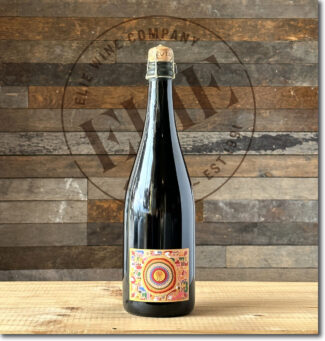 Champagne Lelarge-Pugeot ‘Lùna Volume I’, 2018 Montagne-de-Reims Premier Cru Vrigny Brut Nature ($144)
Champagne Lelarge-Pugeot ‘Lùna Volume I’, 2018 Montagne-de-Reims Premier Cru Vrigny Brut Nature ($144)
An even split of Chardonnay and Pinot Noir, the first of the moon trilogy is meant to be the culmination of the family’s work in biodynamics and continued experiments in natural vinification—indigenous yeast, zero added sulfur, only natural sugar. The vines are between 25 and fifty years old, grown on chalk, limestone, clay loam and sand. Vinification relies on spontaneous fermentation followed by six months of aging in tank or barrel before bottling, then three years on lees in the bottle. The wine shows generous notes of apple, brioche, almond and a precise minerality at the finish. Disgorged April 2022.
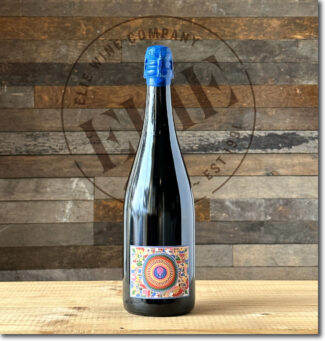 Champagne Lelarge-Pugeot ‘Lùna Volume II’, 2015 Montagne-de-Reims Premier Cru Vrigny Brut Nature ($144)
Champagne Lelarge-Pugeot ‘Lùna Volume II’, 2015 Montagne-de-Reims Premier Cru Vrigny Brut Nature ($144)
From the glittering 2015 vintage—notable for being the hottest season ever recorded in Champagne. Despite smaller than average yields, conditions were such that both Pinot Noir and Chardonnay excelled; ‘Lùna Volume II’ is an even split between the two varieties. The wine has a razor’s edge of acidity; it is crackling, bright and perfectly ripe with yellow citrus, crushed rocks, and notes of yeasty freshly-baked bread. Disgorged April 2022.
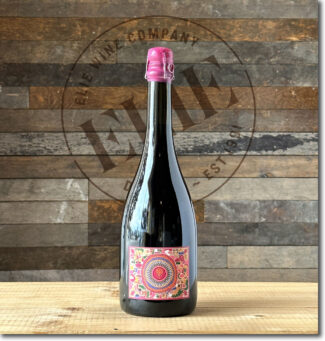 Champagne Lelarge-Pugeot ‘Lùna Volume III’, 2018 Montagne-de-Reims Premier Cru Vrigny Rosé Brut Nature ($144)
Champagne Lelarge-Pugeot ‘Lùna Volume III’, 2018 Montagne-de-Reims Premier Cru Vrigny Rosé Brut Nature ($144)
85% Chardonnay and 15% Pinot Noir from a superb, sunny vintage where the crop was large and healthy, rich in sugar, with all varieties performing well. Volume III saw a short maceration and nine months of barrel-aging followed by three years on the lees, resulting in a wildly complex Champagne with aromas of candied strawberry and a long, rich mineral-driven finish. Disgorged April 2022.
Cru Gueux
The Village Next Door: Lelarge-Pugeot Site-Specific Cru Champagne
The commune of Gueux comprises about 2000 acres of gentle slopes in the northwestern portion of the Petite Montagne in the Montagne de Reims. 85% of the fifty planted acres is Meunier. The area remains somewhat obscure, but with its mix of sand, calcareous clay built around tiny marine fossils fifty million years old, it produces Champagnes that are remarkably terroir-centric, often showing saline notes and a spectacular tension on the palate.
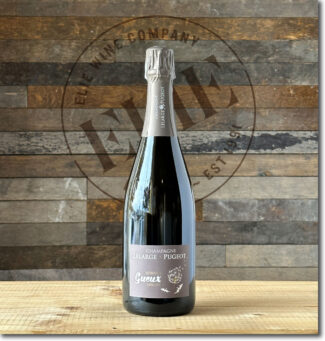 Champagne Lelarge-Pugeot ‘Les Vignes de Gueux’, 2016 Montagne-de-Reims Cru Gueux Extra-Brut ($79)
Champagne Lelarge-Pugeot ‘Les Vignes de Gueux’, 2016 Montagne-de-Reims Cru Gueux Extra-Brut ($79)
75% Meunier, 20% Pinot Noir, 5% Chardonnay; Gueux is a short hop from Vrigny, the wine comes from two lieu-dit parcels: Le Linguet and Le Patenais. The former is a south-east facing plot of Pinot Noir planted on sandy soils in 2005, and the latter, an east-facing parcel of Meunier and four rows of Chardonnay on sandy loam and clay soils. Chardonnay was, in fact, a horticultural error dating back to 1965, but the grapes from these rows allow for even more complexity. Previously sold to négociants, the 2016 vintage shows aromas of preserved lemon, almonds and ginger tea with a laser-focused salinity on the finish. Disgorged June 2021.
Notebook …
Drawing The Boundaries of The Champagne Region
Having been defined and delimited by laws passed in 1927, the geography of Champagne is easily explained in a paragraph, but it takes a lifetime to understand it.
Ninety-three miles east of Paris, Champagne’s production zone spreads across 319 villages and encompasses roughly 85,000 acres. 17 of those villages have a legal entitlement to Grand Cru ranking, while 42 may label their bottles ‘Premier Cru.’ Four main growing areas (Montagne de Reims, Vallée de la Marne, the Côte des Blancs and the Côte des Bar) encompass nearly 280,000 individual plots of vines, each measuring a little over one thousand square feet.
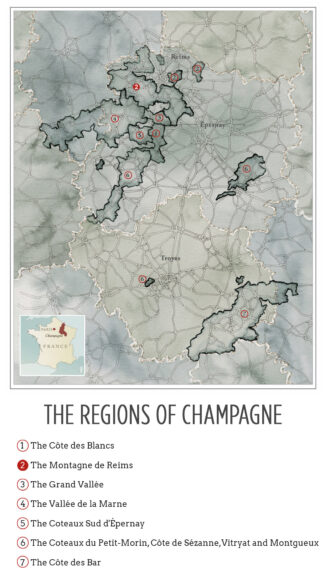
The lauded wine writer Peter Liem expands the number of sub-regions from four to seven, dividing the Vallée de la Marne into the Grand Vallée and the Vallée de la Marne; adding the Coteaux Sud d’Épernay and combining the disparate zones between the heart of Champagne and Côte de Bar into a single sub-zone.
Lying beyond even Liem’s overview is a permutation of particulars; there are nearly as many micro-terroirs in Champagne as there are vineyard plots. Climate, subsoil and elevation are immutable; the talent, philosophies and techniques of the growers and producers are not. Ideally, every plot is worked according to its individual profile to establish a stamp of origin, creating unique wines that compliment or contrast when final cuvées are created.
Champagne is predominantly made up of relatively flat countryside where cereal grain is the agricultural mainstay. Gently undulating hills are higher and more pronounced in the north, near the Ardennes, and in the south, an area known as the Plateau de Langres, and the most renowned vineyards lie on the chalky hills to the southwest of Reims and around the town of Épernay. Moderately steep terrain creates ideal vineyard sites by combining the superb drainage characteristic of chalky soils with excellent sun exposure, especially on south and east facing slopes.
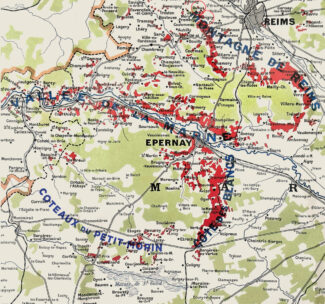
- - -
Posted on 2023.11.10 in Coteaux Champenois, France, Champagne
Featured Wines
- Notebook: A’Boudt Town
- Saturday Sips Wines
- Saturday Sips Review Club
- The Champagne Society
- Wine-Aid Packages
Wine Regions
Grape Varieties
Aglianico, Albarino, Albarín Blanco, Albarín Tinto, Albillo, Aleatico, Arbanne, Aubun, Barbarossa, barbera, Beaune, Biancu Gentile, bourboulenc, Cabernet Franc, Cabernet Sauvignon, Caino, Caladoc, Calvi, Carcajolu-Neru, Carignan, Chablis, Chardonnay, Chasselas, Clairette, Corvina, Cot, Counoise, Erbamat, Ferrol, Fiano, Frappato, Friulano, Fromenteau, Fumin, Garnacha, Gewurztraminer, Godello, Graciano, Grenache, Grolleau, Groppello, Juan Garcia, Lambrusco, Loureira, Macabeo, Macabou, Malvasia, Malvasia Nera, Marsanne, Marselan, Marzemino, Melon de Bourgogne, Merlot, Mondeuse, Montanaccia, Montepulciano, Morescola, Morescono, Moscatell, Muscadelle, Muscat, Natural, Nero d'Avola, Parellada, Patrimonio, Petit Meslier, Petit Verdot, Pineau d'Aunis, Pinot Auxerrois, Pinot Blanc, Pinot Gris, Pinot Meunier, Pinot Noir, Poulsard, Prieto Picudo, Rondinella, Rousanne, Roussanne, Sangiovese, Sauvignon Blanc, Savignin, Semillon, Souson, Sparkling, Sumoll, Sylvaner, Syrah, Tannat, Tempranillo, Trebbiano, Trebbiano Valtenesi, Treixadura, Trousseau, Ugni Blanc, vaccarèse, Verdicchio, Vermentino, Viognier, Viura, Xarel-loWines & Events by Date
- April 2024
- March 2024
- February 2024
- January 2024
- December 2023
- November 2023
- October 2023
- September 2023
- August 2023
- July 2023
- June 2023
- May 2023
- April 2023
- March 2023
- February 2023
- January 2023
- December 2022
- November 2022
- October 2022
- September 2022
- August 2022
- July 2022
- June 2022
- May 2022
- April 2022
- March 2022
- February 2022
- January 2022
- December 2021
- November 2021
- October 2021
- September 2021
- August 2021
- July 2021
- June 2021
- May 2021
- April 2021
- March 2021
- February 2021
- January 2021
- December 2020
- November 2020
- October 2020
- September 2020
- August 2020
- July 2020
- June 2020
- May 2020
- April 2020
- March 2020
- February 2020
- January 2020
- December 2019
- November 2019
- October 2019
- September 2019
- August 2019
- July 2019
- June 2019
- May 2019
- April 2019
- March 2019
- February 2019
- January 2019
- December 2018
- November 2018
- October 2018
- September 2018
- August 2018
- July 2018
- June 2018
- May 2018
- April 2018
- March 2018
- February 2018
- January 2018
- December 2017
- November 2017
- October 2017
- September 2017
- August 2017
- July 2017
- June 2017
- May 2017
- April 2017
- March 2017
- February 2017
- January 2017
- December 2016
- November 2016
- October 2016
- September 2016
- August 2016
- July 2016
- June 2016
- May 2016
- April 2016
- March 2016
- February 2016
- January 2016
- December 2015
- November 2015
- October 2015
- September 2015
- August 2015
- July 2015
- June 2015
- May 2015
- April 2015
- March 2015
- February 2015
- January 2015
- December 2014
- November 2014
- October 2014
- September 2014
- August 2014
- July 2014
- June 2014
- April 2014
- March 2014
- February 2014
- January 2014
- December 2013
- November 2013
- October 2013
- September 2013
- August 2013
- July 2013
- June 2013
- May 2013
- April 2013
- March 2013
- February 2013
- January 2013
- December 2012
- November 2012
- October 2012
- February 2004
Search



